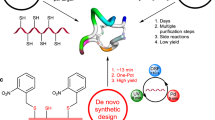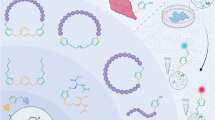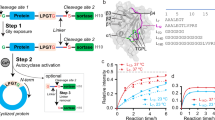Abstract
This protocol provides a detailed procedure for the chemical synthesis of proteins through native chemical ligation of peptide hydrazides. The two crucial stages of this protocol are (i) the solid-phase synthesis of peptide hydrazides via Fmoc chemistry and (ii) the native chemical ligation of peptide hydrazides through in situ NaNO2 activation and thiolysis. This protocol may be of help in the synthesis of proteins that are not easily produced by recombinant technology and that include acid-sensitive modifications; it also does not involve the use of hazardous HF. The utility of the protocol is shown for the total synthesis of 140-aa-long α-synuclein, a protein that has an important role in the development of Parkinson's disease. The whole synthesis of the target protein α-synuclein in milligram scale takes ∼30 working days.
This is a preview of subscription content, access via your institution
Access options
Subscribe to this journal
Receive 12 print issues and online access
$259.00 per year
only $21.58 per issue
Buy this article
- Purchase on Springer Link
- Instant access to full article PDF
Prices may be subject to local taxes which are calculated during checkout




Similar content being viewed by others
References
Kent, S.B.H. Total chemical synthesis of proteins. Chem. Soc. Rev. 38, 338–351 (2009).
Nilsson, B.L., Soellner, M.B. & Raines, R.T. Chemical synthesis of proteins. Annu. Rev. Biophys. Biomol. Struct. 34, 91–118 (2005).
Yeates, T.O. & Kent, S.B.H. Racemic protein crystallography. Annu. Rev. Biophys. 41, 41–61 (2012).
Dawson, P.E., Muir, T.W., Clark-Lewis, I. & Kent, S.B.H. Synthesis of proteins by native chemical ligation. Science 266, 776–779 (1994).
Johnson, E.C.B. & Kent, S.B.H. Insights into the mechanism and catalysis of the native chemical ligation reaction. J. Am. Chem. Soc. 128, 6640–6646 (2006).
Schnolzer, M., Alewood, P., Jones, A., Alewood, D. & Kent, S.B.H. In situ neutralization in Boc-chemistry solid phase peptide synthesis. Int. J. Pept. Res. Ther. 13, 31–44 (2007).
Shin, Y. et al. Fmoc-based synthesis of peptide-thioesters: application to the total chemical synthesis of a glycoprotein by native chemical ligation. J. Am. Chem. Soc. 121, 11684–11689 (1999).
Huse, M., Holford, M.N., Kuriyan, J. & Muir, T.W. Semisynthesis of hyperphosphorylated type I TGF-β receptor: addressing the mechanism of kinase activation. J. Am. Chem. Soc. 122, 8337–8338 (2000).
Tolbert, T.J. & Wong, C.-H. Intein-mediated synthesis of proteins containing carbohydrates and other molecular probes. J. Am. Chem. Soc. 122, 5421–5428 (2000).
Ingenito, R., Bianchi, E., Fattori, D. & Pessi, A. Solid phase synthesis of peptide C-terminal thioesters by Fmoc/t-Bu chemistry. J. Am. Chem. Soc. 121, 11369–11374 (1999).
Kawakami, T. & Aimoto, S. Peptide ligation using a building block having a cysteinyl prolyl ester (CPE) autoactivating unit at the carboxy terminus. Chem. Lett. 36, 76–77 (2007).
Blanco-Canosa, J.B. & Dawson, P.E. An efficient Fmoc-SPPS approach for the generation of thioester peptide precursors for use in native chemical ligation. Angew. Chem. Int. Ed. 47, 6851–6855 (2008).
Tofteng, A.P., Sorensen, K.K., Conde-Frieboes, K.W., Hoeg-Jensen, T. & Jensen, K.J. Fmoc solid-phase synthesis of C-terminal peptide thioesters by formation of a backbone pyroglutamyl imide moiety. Angew. Chem. Int. Ed. 48, 7411–7414 (2009).
Kang, J., Richardson, J.P. & Macmillan, D. 3-Mercaptopropionic acid-mediated synthesis of peptide and protein thioesters. Chem. Commun. 2009, 407–409 (2009).
Tsuda, S., Shigenaga, A., Bando, K. & Otaka, A. N-to-S acyl-transfer-mediated synthesis of peptide thioesters using anilide derivatives. Org. Lett. 11, 823–826 (2009).
Zheng, J.S., Cui, H.K., Fang, G.M., Xi, W.X. & Liu, L. Chemical protein synthesis by kinetically controlled ligation of peptide O-esters. ChemBioChem 11, 511–515 (2010).
Ollivier, N., Dheur, J., Mhidia, R., Blanpain, A. & Melnyk, O. Bis(2-sulfanylethyl)amino native peptide ligation. Org. Lett. 12, 5238–5241 (2010).
Zheng, J.S., Chang, H.N., Wang, F.L. & Liu, L. Fmoc synthesis of peptide thioesters without post-chain-assembly manipulation. J. Am. Chem. Soc. 133, 11080–11083 (2011).
Fang, G.M. et al. Protein chemical synthesis by ligation of peptide hydrazides. Angew. Chem. Int. Ed. 50, 7645–7649 (2011).
Fang, G.M., Wang, J.X. & Liu, L. Convergent chemical synthesis of proteins by ligation of peptide hydrazides. Angew. Chem. Int. Ed. 51, 10347–10350 (2012).
Zheng, J.S., Tang, S., Guo, Y., Chang, H.N. & Liu, L. Synthesis of cyclic peptides and cyclic proteins via ligation of peptide hydrazides. ChemBioChem 13, 542–546 (2012).
Tang, S., Zheng, J.S., Yang, K. & Liu, L. Synthesis of cyclic tetrapeptides via ligation of peptide hydrazides. Acta Chim. Sinica 70, 1471–1476 (2012).
Li, Y.M. et al. Ligation of expressed protein α-hydrazides via genetic incorporation of an α-hydroxy acid. ACS Chem. Biol. 7, 1015–1022 (2012).
Siman, P., Karthikeyan, S.V., Nikolov, M., Fischle, W. & Brik, A. Convergent chemical synthesis of histone H2B protein for the site-specific ubiquitination at Lys34. Angew. Chem. Int. Ed. 52, 8059–8063 (2013).
Cremades, N. et al. Direct observation of the interconversion of normal and toxic forms of α-synuclein. Cell 149, 1048–1059 (2012).
Luk, K.C. et al. Pathological α-synuclein transmission initiates Parkinson-like neurodegeneration in nontransgenic mice. Science 338, 949–953 (2012).
Lashuel, H.A., Overk, C.R., Oueslati, A. & Masliah, E. The many faces of α-synuclein: from structure and toxicity to therapeutic target. Nat. Rev. Neurosci. 14, 38–48 (2013).
Paleologou, K.E. et al. Phosphorylation at S87 is enhanced in synucleinopathies, inhibits α-synuclein oligomerization, and influences synuclein-membrane interactions. J. Neurosci. 30, 3184–3198 (2010).
Braithwaite, S.P., Stock, J.B. & Mouradian, M.M. α-Synuclein phosphorylation as a therapeutic target in Parkinson's disease. Rev. Neurosci. 23, 191–198 (2012).
Hejjaoui, M. et al. Elucidating the role of C-terminal post-translational modifications using protein semisynthesis strategies: α-synuclein phosphorylation at tyrosine 125. J. Am. Chem. Soc. 134, 5196–5210 (2012).
Wan, Q. & Danishefsky, S.J. Free-radical-based, specific desulfurization of cysteine: a powerful advance in the synthesis of polypeptides and glycopolypeptides. Angew. Chem. Int. Ed. 46, 9248–9252 (2007).
Rochet, J.C., Conway, K.A. & Lansbury, P.T. Jr. Inhibition of fibrillization and accumulation of prefibrillar oligomers in mixtures of human and mouse α-synuclein. Biochemistry 39, 10619–10626 (2000).
Carpino, L.A. et al. The uronium/guanidinium peptide coupling reagents: finally the true uronium salts. Angew. Chem. Int. Ed. 41, 441–445 (2002).
Palladino, P. & Stetsenko, D.A. New TFA-free cleavage and final deprotection in Fmoc solid-phase peptide synthesis: dilute HCl in fluoro alcohol. Org. Lett. 14, 6346–6349 (2012).
Kaiser, E., Colescot, R.L., Bossinge, C.D. & Cook, P.I. Color test for detection of free terminal amino groups in solid-phase synthesis of peptides. Anal. Biochem. 34, 595–598 (1970).
Acknowledgements
This study was supported by the National Basic Research Program of China (973 program, no. 2013CB932800), the '863' Program of the Ministry of Science and Technology (grant no. 2012AA02A700), the National Natural Science Foundation of China (grants no. 20932006), National Science Fund for Distinguished Young Scholars and the Specialized Research Fund for the Doctoral Program of Higher Education (grant no. 20120002130004). We thank T. Chu and Y. Chen for technical assistance in the biophysical characterization of synthetic α-synuclein 8.
Author information
Authors and Affiliations
Contributions
L.L. conceived and led the project. J.-S.Z., S.T., Y.-K.Q. and Z.-P.W. conducted the experiments and co-wrote the manuscript with L.L.
Corresponding author
Ethics declarations
Competing interests
The authors declare no competing financial interests.
Integrated supplementary information
Supplementary Figure 2 RP-HPLC analysis of α-synuclein(1-29)-NHNH2 running on a C4-column.
The linear gradient for analytical HPLC: 5% buffer B in buffer A to 95% B in A over 30 min at rt with flow rate 1 mL/min (Left: the crude and Right: purified).
Supplementary Figure 4 RP-HPLC analysis of α-synuclein(30-68, A30C)-NHNH2 running on a C4-column.
The linear gradient for analytical HPLC: 5% buffer B in buffer A to 95% B in A over 30 min at rt (Left: the crude and Right: purified).
Supplementary Figure 6 RP-HPLC analysis of α-synuclein(69-106, A69C)-NHNH2 running on a C4-column.
The linear gradient for analytical HPLC: 5% buffer B in buffer A to 95% B in A over 30 min at rt (Left: the crude and Right: purified).
Supplementary Figure 8 RP-HPLC analysis of α-synuclein(107-140, A107C)-OH running on a C4-column.
The linear gradient for analytical HPLC: 5% buffer B in buffer A to 95% B in A over 30 min at rt (Left: the crude and Right: purified).
Supplementary Figure 10 SDS-PAGE analysis and circular dichroism spectrum of 8.
(a) SDS-PAGE analysis and (b) circular dichroism spectra of synthetic α-synuclein 8 (proteins (∼10 μM) were dissolved in 20 mM sodium phosphate pH 7.4 and analyzed in a 1 mm quartz cell).
Supplementary Figure 11 Thioflavin T assays of purified α-synuclein 8.
The sample with 10 μM (containing 20 mM Tris, 150 mM NaCl, pH 7.5) is incubated at 37° C. Aliquots are taken and analyzed by ThT fluorescence (450 nm/482 nm) at the indicated time points. The experiments are performed in triplicate.
Supplementary information
Supplementary Figure 1
The general chemical synthetic strategy of α-synuclein 8. (PDF 282 kb)
Supplementary Figure 2
RP-HPLC analysis of α-synuclein(1-29)-NHNH2 running on a C4-column. The linear gradient for analytical HPLC: 5% buffer B in buffer A to 95% B in A over 30 min at rt with flow rate 1 mL/min (Left: the crude and Right: purified). (PDF 216 kb)
Supplementary Figure 3
ESI-MS of α-synuclein(1-29)-NHNH2. (PDF 157 kb)
Supplementary Figure 4
RP-HPLC analysis of α-synuclein(30-68, A30C)-NHNH2 running on a C4-column. The linear gradient for analytical HPLC: 5% buffer B in buffer A to 95% B in A over 30 min at rt (Left: the crude and Right: purified). (PDF 739 kb)
Supplementary Figure 5
ESI-MS of α-synuclein(30-68, A30C)-NHNH2. (PDF 79 kb)
Supplementary Figure 6
RP-HPLC analysis of α-synuclein(69-106, A69C)-NHNH2 running on a C4-column. The linear gradient for analytical HPLC: 5% buffer B in buffer A to 95% B in A over 30 min at rt (Left: the crude and Right: purified). (PDF 235 kb)
Supplementary Figure 7
ESI-MS of α-synuclein(69-106, A69C)-NHNH2. (PDF 180 kb)
Supplementary Figure 8
RP-HPLC analysis of α-synuclein(107-140, A107C)-OH running on a C4-column. The linear gradient for analytical HPLC: 5% buffer B in buffer A to 95% B in A over 30 min at rt (Left: the crude and Right: purified). (PDF 236 kb)
Supplementary Figure 9
ESI-MS of α-synuclein(107-140, A107C)-OH. (PDF 174 kb)
Supplementary Figure 10
SDS-PAGE analysis and circular dichroism spectrum of 8. (a) SDS-PAGE analysis and (b) circular dichroism spectra of synthetic α-synuclein 8 (proteins (∼10 μM) were dissolved in 20 mM sodium phosphate pH 7.4 and analyzed in a 1 mm quartz cell). (PDF 292 kb)
Supplementary Figure 11
Thioflavin T assays of purified α-synuclein 8. The sample with 10 μM (containing 20 mM Tris, 150 mM NaCl, pH 7.5) is incubated at 37° C. Aliquots are taken and analyzed by ThT fluorescence (450 nm/482 nm) at the indicated time points. The experiments are performed in triplicate. (PDF 201 kb)
Supplementary Data 1
RP-HPLC trace of native chemical ligation of 1 with 2 running on a C4- column. (PDF 550 kb)
Supplementary Data 2
RP-HPLC trace of native chemical ligation of α-synuclein(1-68, A30C)-NHNH2 with α-synuclein(68-106, A69C)-NHNH2 running on a C4-column. (PDF 496 kb)
Supplementary Data 3
RP-HPLC trace of native chemical ligation of α-synuclein(1-106, A30,69C)-NHNH2 with α-synuclein(107-140, A107C)-OH running on a C4-column. (PDF 333 kb)
Supplementary Data 4
RP-HPLC trace of desulfurization of α-synuclein(1-140, A30,69,107C)-OH running on a C4-column. (PDF 425 kb)
Rights and permissions
About this article
Cite this article
Zheng, JS., Tang, S., Qi, YK. et al. Chemical synthesis of proteins using peptide hydrazides as thioester surrogates. Nat Protoc 8, 2483–2495 (2013). https://doi.org/10.1038/nprot.2013.152
Published:
Issue Date:
DOI: https://doi.org/10.1038/nprot.2013.152
This article is cited by
-
Recent advances in chemical protein synthesis: method developments and biological applications
Science China Chemistry (2024)
-
Development of competitive and noncompetitive lateral flow immunoassays for pendimethalin using synthetic peptides
Microchimica Acta (2024)
-
Roles of inter- and intramolecular tryptophan interactions in membrane-active proteins revealed by racemic protein crystallography
Communications Chemistry (2023)
-
Synthesis and applications of mirror-image proteins
Nature Reviews Chemistry (2023)
-
A bifunctional molecule-assisted synthesis of mimics for use in probing the ubiquitination system
Nature Protocols (2023)
Comments
By submitting a comment you agree to abide by our Terms and Community Guidelines. If you find something abusive or that does not comply with our terms or guidelines please flag it as inappropriate.



